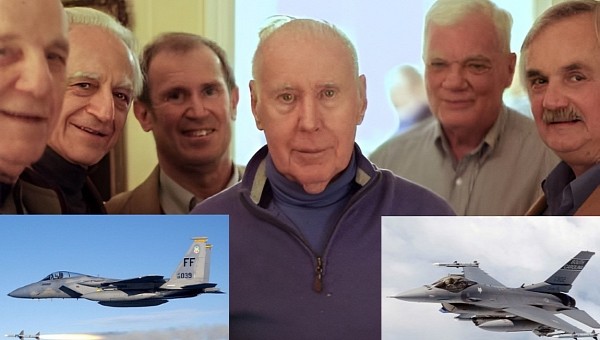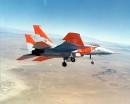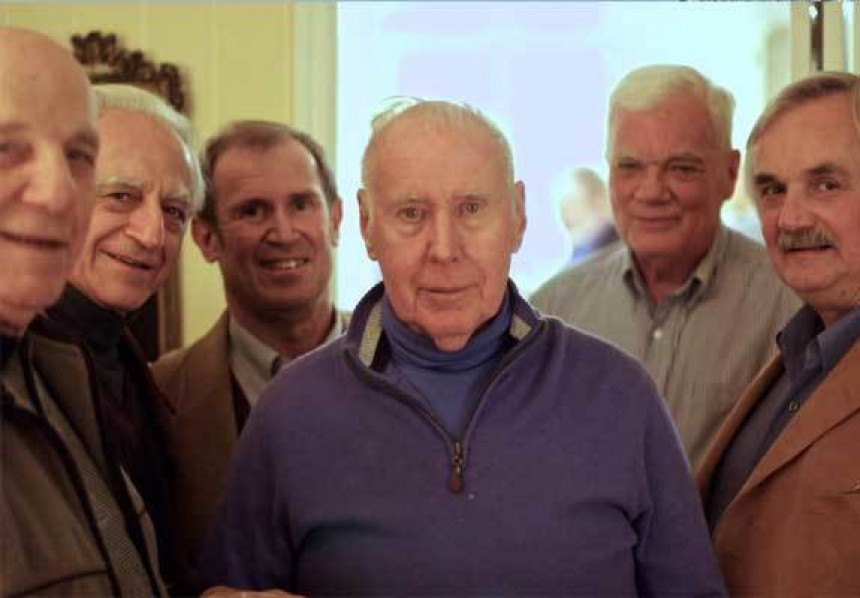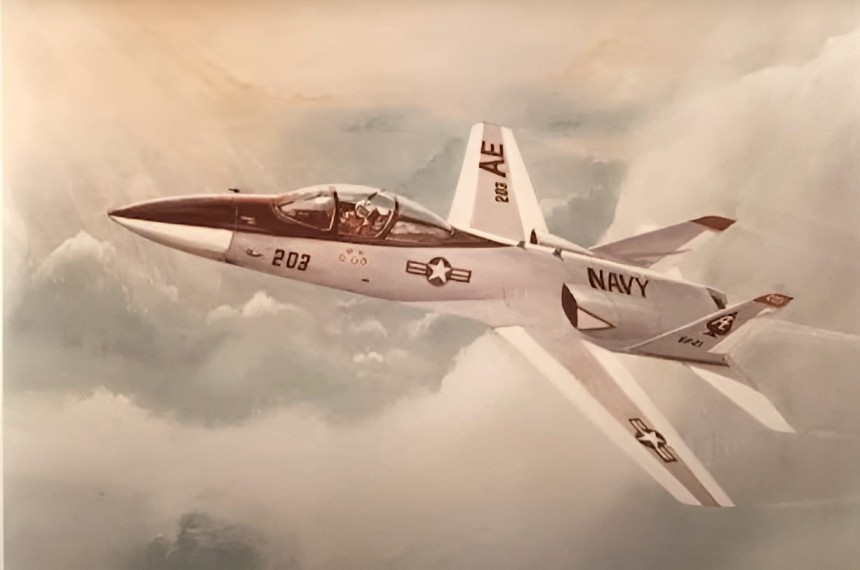If we told you a secret think tank full of U.S. Air Force, Department of Defense, and private defense analyst personnel once sat in a dark, smoke-filled room and painstakingly planned out the future of U.S. fighter jets, would you believe us?
Oh, and to make things more interesting, some of the people purported to be in this secret club have a bone to pick with the F-35 program. It's as if someone's trying to sell us the idea for a cool war movie. This is the story of the Fighter Mafia. If you believe it at face value, these people were pivotal in bringing us the F-15 Eagle, F-16 Fighting Falcon, and even the A-10. As you'll find, taking some of these claims at face value is pretty hard.
First things first, a group name like Fighter Mafia has some pretty unsavory implications behind it. But at least from most perspectives, the Fighter Mafia didn't have any overtly malicious intentions. Rather, they simply had very strong opinions about the direction the U.S. Air Force was headed after the Vietnam War. Opinions that made people perceive this group as adversarial to Pentagon top brass in the same way New York and Chicago's mafia are to the FBI.
The group, as most Cold War historians identify it, began, at the earliest, in 1964. A time when American fighter jets like the initially cannon-devoid F4 Phantom II were about to get their collective rear ends handed to them by North Vietnamese MiG-17s, MiG-19s, and occasionally, MiG-21s. In an era where American fighter jets were more like glorified missile trucks, sentiment among big-wigs in aerospace was growing quickly against this line of thinking.
And so, that brings us to perhaps two of the three most important figures in the Fighter Mafia. Everest Riccioni, its founder and long-time leading man, and a former F-86 Sabre pilot called John Richard Boyd. Boyd was already an icon in military aviation for his groundbreaking work with high-to-low altitude energy-based (boom and zoom) dogfighting tactics. This tactic essentially let jet pilots trade altitude for speed, and then used this speed like a passive form of armor. But his most famous contribution to military aviation had to be the OODA loop (observe-orient-decide-attack) code of conduct for American fighter pilots engaging in a dogfight.
Safe to say, old timers like Boyd and Riccioni looked at the initially-gunless F-4 Phantom II program and despaired at their miserable performances in dogfights over Vietnam. The concept of fighters only carrying missiles fired from beyond visual range without guns or cannons was still decades away from viability. That said, this foolhardy dogma becoming the go-to USAF dogfighting strategy was enough to make these aspiring reformers furious. Luckily for Boyd, there were friends of his in relatively high places who felt the same way.
This brings us to some of John Boyd's first introductions into the Fighter Mafia, private defense analyst Thomas P. Christie, aviation pioneer and former Air Force Lieutenant Charles E. Myres, and perhaps the group's most polarizing member, an extremely talented audio engineer and Jazz musician turned the face of the Fighter Mafia reformers movement called Pierre Sprey. Sprey later claimed many times, including on Russian State media, to have unequivocally been vital to the development of the F-15, F-16, and the A-10.
In truth, the closest an admittedly otherwise very talented Pierre Sprey came to developing fighter jets by was working as a statistician for Grumman Aerospace Corporation of Bethpage, Long Island, New York. The makers of, among other things, the A6 Intruder, the E-2 Hawkeye, and the F-14 Tomcat Navy fighter. He was also reasonably well connected to John Boyd, having used his connections at Grumman to network with people who could introduce the two men.
Before going further, it's important to understand that the Fighter Mafia's PR machine makes detailing its history more than a little bit murky. But we've done our best to piece it all together using as legitimate of sources as we could come across. As legend tells, the plans the U.S. Air Force planned for its next-generation of fighter jets before Vietnam was more or less much of the same missile truck approach that would only be proven ineffective a few years later.
This stunning come-to-the-lord moment for the Air Force prompted whatever the Pentagon had planned for a fighter plane before Vietnam to be scrapped. Aside from the F-4 and the F-111 swing-wing fighter bomber, it all would've been insufficient. Instead, the Air Force focused their efforts on two new programs, albeit not exactly at the same time. First, there was the F-X program, or what would become known as Project Red Bird, and then later, the F-15 Eagle.
Secondly, there was the Light Weight Fighter (LWF) initiative that became the F-16 Fighting Falcon. So the story goes, John Boyd, Chuck Myers, Everest Riccioni, and Pierre Sprey were all part of a special advisers group for both projects, starting with Project Red Bird. The group was hired as consultants by the Department of Defense and allowed first-hand access to the airplane's blueprints. Keep in mind, this was well before anyone in the civilian space had even heard of the F-15. What the Fighter Mafia saw, at least to them, was an outrage.
In the eyes of the Fighter Mafia, Project Red Bird was an overengineered, expensive contraption that was far too heavily invested in missiles, radar, and other costly technologies. In a stark rejection of the Air Force's plans, Boyd, Sprey, Myers, and Riccioni proposed a counter design unsubtly christened Project Blue Bird, or the F-XX as Pierre Sprey called it.
This proposal had only a bare minimum of fuel capacity, could only operate during the daytime in fair weather, had no radar or afterburner, and, get this, had no mounts for missiles whatsoever. All thanks to Pierre Sprey's pal John Boyd's philosophy of only holding enough fuel for the dogfight and not much more beyond
How on Earth was this the case? What exactly did the Fighter Mafia have planned as armament for this most spartan of jet fighters? Well, a comical fuel capacity in the F-XX was reduced to accommodate the Gau-8 Avenger, the 30.mm "BRRRRRTTT" machine famous for its use on the A-10 Thunderbolt II. Did we mention Pierre Sprey claimed to have developed the A-10 on Russia Today news in an article where he trashed the F-35? This claim was an unsubstantiated crock of something foul-smelling as well.
According to a declassified report by the Air Force titled "The F-15 Eagle: Origins and Development 1964 to 1972," Pierre Sprey once barged into a joint Air Force/DOD meeting room where the F-15 was being discussed and frantically proposed they scrap the whole Eagle program in favor of his F-XX design. A design that, at face value, was like an American take on a Soviet MiG-21 but without any of the upsides. As you'd expect, Sprey was allegedly told politely yet firmly to leave. This is Sprey's only mention in regards to the F-15 program in any formal capacity.
For most groups, that'd be the end of it all. But because this is the military-industrial complex at work, this tale is only one story in a prolific web of exaggerated claims of a group that'd go on to be dubbed The Reformers in the 1980s.
In the meantime, we'd like to very much thank the legitimate internet military historian and hilarious YouTuber LazerPig for being instrumental in the research of this article. There's so much smoke-and-mirrors around the mystique of the Fighter Mafia that trustworthy sources are hard to come across. Feel free to check out his video below.
First things first, a group name like Fighter Mafia has some pretty unsavory implications behind it. But at least from most perspectives, the Fighter Mafia didn't have any overtly malicious intentions. Rather, they simply had very strong opinions about the direction the U.S. Air Force was headed after the Vietnam War. Opinions that made people perceive this group as adversarial to Pentagon top brass in the same way New York and Chicago's mafia are to the FBI.
The group, as most Cold War historians identify it, began, at the earliest, in 1964. A time when American fighter jets like the initially cannon-devoid F4 Phantom II were about to get their collective rear ends handed to them by North Vietnamese MiG-17s, MiG-19s, and occasionally, MiG-21s. In an era where American fighter jets were more like glorified missile trucks, sentiment among big-wigs in aerospace was growing quickly against this line of thinking.
And so, that brings us to perhaps two of the three most important figures in the Fighter Mafia. Everest Riccioni, its founder and long-time leading man, and a former F-86 Sabre pilot called John Richard Boyd. Boyd was already an icon in military aviation for his groundbreaking work with high-to-low altitude energy-based (boom and zoom) dogfighting tactics. This tactic essentially let jet pilots trade altitude for speed, and then used this speed like a passive form of armor. But his most famous contribution to military aviation had to be the OODA loop (observe-orient-decide-attack) code of conduct for American fighter pilots engaging in a dogfight.
This brings us to some of John Boyd's first introductions into the Fighter Mafia, private defense analyst Thomas P. Christie, aviation pioneer and former Air Force Lieutenant Charles E. Myres, and perhaps the group's most polarizing member, an extremely talented audio engineer and Jazz musician turned the face of the Fighter Mafia reformers movement called Pierre Sprey. Sprey later claimed many times, including on Russian State media, to have unequivocally been vital to the development of the F-15, F-16, and the A-10.
In truth, the closest an admittedly otherwise very talented Pierre Sprey came to developing fighter jets by was working as a statistician for Grumman Aerospace Corporation of Bethpage, Long Island, New York. The makers of, among other things, the A6 Intruder, the E-2 Hawkeye, and the F-14 Tomcat Navy fighter. He was also reasonably well connected to John Boyd, having used his connections at Grumman to network with people who could introduce the two men.
Before going further, it's important to understand that the Fighter Mafia's PR machine makes detailing its history more than a little bit murky. But we've done our best to piece it all together using as legitimate of sources as we could come across. As legend tells, the plans the U.S. Air Force planned for its next-generation of fighter jets before Vietnam was more or less much of the same missile truck approach that would only be proven ineffective a few years later.
Secondly, there was the Light Weight Fighter (LWF) initiative that became the F-16 Fighting Falcon. So the story goes, John Boyd, Chuck Myers, Everest Riccioni, and Pierre Sprey were all part of a special advisers group for both projects, starting with Project Red Bird. The group was hired as consultants by the Department of Defense and allowed first-hand access to the airplane's blueprints. Keep in mind, this was well before anyone in the civilian space had even heard of the F-15. What the Fighter Mafia saw, at least to them, was an outrage.
In the eyes of the Fighter Mafia, Project Red Bird was an overengineered, expensive contraption that was far too heavily invested in missiles, radar, and other costly technologies. In a stark rejection of the Air Force's plans, Boyd, Sprey, Myers, and Riccioni proposed a counter design unsubtly christened Project Blue Bird, or the F-XX as Pierre Sprey called it.
This proposal had only a bare minimum of fuel capacity, could only operate during the daytime in fair weather, had no radar or afterburner, and, get this, had no mounts for missiles whatsoever. All thanks to Pierre Sprey's pal John Boyd's philosophy of only holding enough fuel for the dogfight and not much more beyond
According to a declassified report by the Air Force titled "The F-15 Eagle: Origins and Development 1964 to 1972," Pierre Sprey once barged into a joint Air Force/DOD meeting room where the F-15 was being discussed and frantically proposed they scrap the whole Eagle program in favor of his F-XX design. A design that, at face value, was like an American take on a Soviet MiG-21 but without any of the upsides. As you'd expect, Sprey was allegedly told politely yet firmly to leave. This is Sprey's only mention in regards to the F-15 program in any formal capacity.
For most groups, that'd be the end of it all. But because this is the military-industrial complex at work, this tale is only one story in a prolific web of exaggerated claims of a group that'd go on to be dubbed The Reformers in the 1980s.
In the meantime, we'd like to very much thank the legitimate internet military historian and hilarious YouTuber LazerPig for being instrumental in the research of this article. There's so much smoke-and-mirrors around the mystique of the Fighter Mafia that trustworthy sources are hard to come across. Feel free to check out his video below.










